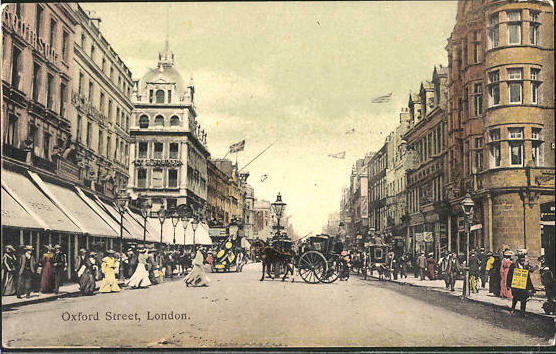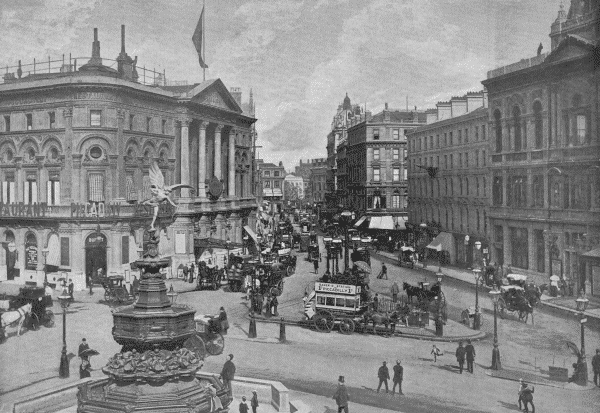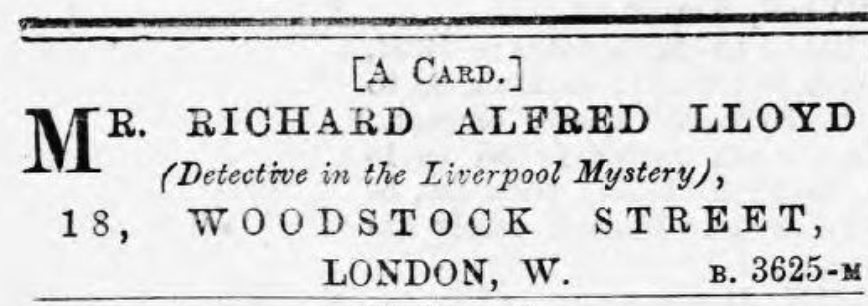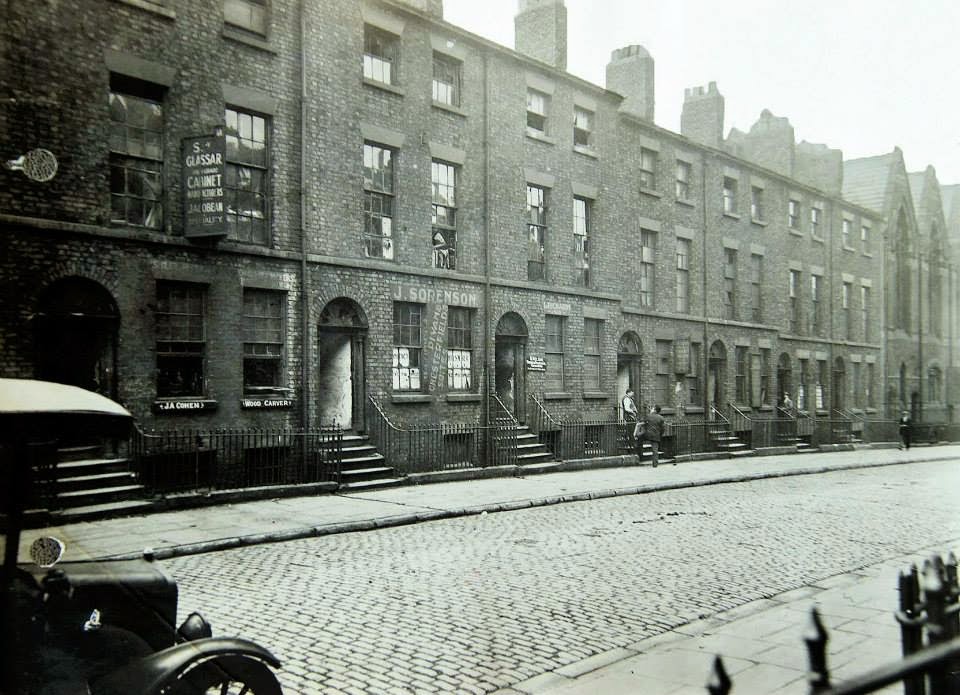On Wednesday 3 September 1879, an 18-year-old woman called Elizabeth Mary Edwards disappeared from a busy street in Liverpool while on her way to settle some household bills and call at a few shops. Despite an intense search and massive publicity across the entire country about what was called the “Edwards Mystery”, there was no trace of her. Many, including Miss Edwards’ family, suspected that she had come to harm; others – despite her parents’ insistence that she had always been happy, placid and obedient – wondered if she had simply run away. A complicating factor was that she had recently become engaged, but her family assured everyone that she was very much in love with her fiancé. The only clues were a handful of potential sightings, the most promising of which placed her in Shrewsbury, heading for London, on 4 September. By mid-October, Miss Edwards had been missing for six weeks but was still featured in newspaper reports and the subject of much discussion in correspondence sections.
In early October, a crucial new figure became involved in the Edwards Mystery: a private detective. Mr Richard Alfred Lloyd had been in the Liverpool police for five years but had left when he inherited property; he set himself up as a detective in London from around 1875. At this time, he was living in an apartment at 18 Woodstock Street in Grosvenor Square. Several newspapers gave details about him. He was around thirty years old, with “a somewhat military air”. Originally from Wales, fluent in Welsh and an accomplished poet in that language, Lloyd had previously won prizes at the Eisteddfod.
Lloyd gave his own account of what happened in the pages of the Daily Telegraph (24 October). He first read about the Edwards Mystery on Saturday 4 October and saw the description of Miss Edwards. He decided, in his own words, that “I might turn my attention in this direction with advantage, especially as I was not otherwise particularly engaged.” He claimed to have “a special faculty for recognising people, however disguised, by means of their photographs”. With this in mind, he wrote to Miss Edwards’ father, Edward Edwards, on Sunday 5 October asking for a photograph of his daughter, and received one on 8 October.

Postcard showing Oxford Street, where Lloyd first saw Miss Edwards. The shop Peter Robinson’s is on the left with the canopy. It seems implausible that he would have found her at random in such a busy place on the first day of his search.
Lloyd began searching on the morning of Thursday 9 October. He claimed that, the very same evening, at 8:30pm, he saw a woman who looked like Miss Edwards at “Mr Peter Robinson’s, Regent Circus” (early accounts said he saw her at Finsbury Circus). Even though she was not dressed as Miss Edwards had been when she disappeared, Lloyd thought the resemblance was great and watched her closely. She was alone and walking slowly, so he made a passing remark to her, to which she replied “in a modest and ladylike manner” that she could not stop to talk as she was in a hurry to get home. He was so certain it was her, he considered immediately calling a cab to take her somewhere safe, but realised that he had no authority from the family to do so. He wrote to Mr Edwards, but received no reply, perhaps, as Lloyd himself thought, because he “had got incredulous, owing to the many communications he received, all ending in nothing.” But Lloyd was confident he would see her again, and indeed did so on the evening of Sunday 12 October at Piccadilly Circus. This time she was with another young woman whom Lloyd described as “better dressed” than her. He spoke to the suspected Miss Edwards once more, but she “was distressed somewhat by my addressing her, and said she did not think it proper to speak to a stranger in the street.” By now, he was convinced he had found the missing woman, and that “it was clear she had only just come to London.”
That night Lloyd wrote to Edwards again, asking for the name of someone in London who would know his daughter by sight. Edwards once more did not reply, but a few days later, on the Thursday 16 October, Samuel Campbell arrived in London; Campbell, a friend of the Edwards family (although some newspapers described him as a relative) had already travelled far and wide in search of Miss Edwards, and had engaged in a spirited defence of the family’s position in the press. Now he had come to check out Lloyd’s story.

Piccadilly Circus, London, where Lloyd found Miss Edwards for a second time (Image: victorianlondon.org)
Lloyd and Campbell searched together for two days but without success. Although Campbell remained unconvinced that Lloyd had even seen Miss Edwards, just before he retuned home he gave the name and address of her uncle, a businessman who lived in London. Lloyd continued the search alone. It was not until Monday 20 October that he saw her again, this time at Regent Street but in the company of the same woman as before. He followed them for two hours – “the greater part of which they spent wandering listlessly and apparently without aim, principally in the park. They seemed to avoid being accosted. I did not see them speak to anyone. They left the park unaccompanied, and went to a highly respectable terrace in Brompton, where they occupied the parlours of a seven-roomed house – as I judged from without.” They left the house again later. Lloyd sent a telegram to Miss Edwards’ uncle, and waited for them to return. The uncle (whose name was never printed, but he was identified as her mother’s brother) arrived two hours later, and after the two men had waited for a further hour, the two women came back around 9pm. Unobserved, the two men watched so that the uncle could see the possible Miss Edwards. At first, Lloyd reported that he was simply “bewildered”, then thought that there was a resemblance. Gradually, he concluded that it was his niece.
Lloyd confronted her by saying “Miss Edwards, I want to speak to you,” and said that her uncle was there. Initially she denied having an uncle but Lloyd (a “little roughly” by his own account) told her it was no use and she should admit the truth. The woman spoke to her companion before turning back and admitting, “Yes, uncle, it is me.” She became quite distressed, hinting that “something dreadful” had happened, but thanked Lloyd for finding her. She went with her uncle to his house, and her parents were sent for (although Edwards did not initially believe the telegram and sent a message to the uncle in London to corroborate what Lloyd said) arriving in London on the Tuesday. Lloyd made clear that he knew nothing about the woman with whom Miss Edwards had been staying but had asked her landlady, who “gives her the highest character, and certainly I have seen no approach to misconduct with her.” He believed the two women walked out at night through boredom rather than any sinister reason. He also hoped to be given enough information to track down the person responsible for her plight.

As we shall see, Miss Edwards remained in London for some time at her uncle’s house with her father (who had to return to Liverpool a few days after) and mother; her fiancé also visited. This was, however, Lloyd’s last active part in the story. Around a month after he had found Miss Edwards, he still had not received the promised £100 reward. Reports began to appear in newspapers that he was preparing legal action to recover the amount. Matters were quickly settled after this, and at the end of November, the ubiquitous Samuel Campbell visited Lloyd in London and paid him on behalf of Edward Edwards – or as the report by the Central News press agency said, Lloyd “had his claim amicably and honourably adjusted for his services”. The publicity of the case did no harm to Lloyd’s career and newspapers said that since his discovery of Miss Edwards, “he has been inundated with commissions from persons with inquiries to be made.” Within a week, he had supposedly found a missing child using his ability to find people from their photograph, and was investigating the disappearance of a young man from Dartmouth. Lloyd contributed a two-part article to the North Wales Express entitled “Reminiscences of a Welsh Detective in London” in January 1880 in which he implies that he specialised in finding missing people who had fled to London; several issues of the same publication also carried an advertisement from Lloyd in which he called himself the “Detective in the Liverpool Mystery”.
Although he featured in no other famous stories, Lloyd continued to have a varied life. By the time of the 1881 census, he was still a private detective, living at 19 Old Quebec Street in Marylebone, along with a lodger, Miss Winifred Morgan, a 36-year-old who was also from Wales, and a 12-year-old servant, Ernest Pashley. He also called himself a a private detective when, in November that same year, he married Mary Margaret Thomson. By 1891, the couple lived at 205 Regent Street with their two children, Blodwen and Richard; Lloyd was no longer a detective but seemed to be hedging his bets: under “occupation” he has “managing director”, “trader” and “pro[fessional?] accountant”.
In 1901, Lloyd and his wife lived at 23 Blandford Road with Richard, their daughter Gwendolyn (Blodwen now was a pupil at Ashford Welsh Girls’ School), and his wife’s mother. He now gave his occupation as “secret service agent”, although he listed himself as what would today be called self-employed. The London Gazette in May 1902 carried an announcement giving notice that the “Detectives and Mercantile Agents” known as Lloyds, run by Richard Alfred Lloyd and John Elystan Lloyd, was dissolved. A further mention comes in the London Evening Standard (1 May 1909) when “Mr Richard Alfred Lloyd, a private inquiry agent , of Fleet Street, residing at Sidcup” was awarded “damages for personal injuries” of £152 10s against Mrs R Blair Maconochie of Maidstone. Lloyd had been riding a bicycle the previous year with “a friend of his, Miss Johnson” in Maidstone when the defendant’s car (driven by a chauffeur) knocked him over, causing several fractures. The Whitstable Times and Herne Bay Herald (8 May 1909) added further details from the case, including that Lloyd’s hearing, memory and eyesight had been affected, and he now suffered from “giddiness”. This had forced him to give up his business; in his evidence, Lloyd said that “he had been decorated by French, Turkish and Austrian Governments for work he had done for the Embassies.”
In 1911, Mr and Mrs Lloyd lived at 55 Stafford Road in Sidcup with their daughter Gwendolyn, and Lloyd called himself a “retired accountant”, presumably still being unable to work after his accident. He seems to have died in 1932, but it is hard to be certain owing to his name being quite common. However, his wife was a widow when she died in 1936. It is not entirely clear what we should make of Mr Lloyd – poet, policeman, detective, accountant, secret agent. How much of this was self-publicity is unclear, but his wife left £3090 3s 9d (worth around £200,000 today) in her will to their son, who was a schoolmaster at the time.
Whatever he did afterwards, Lloyd certainly played a key role in the Edwards mystery. But there are a few questions about his account of what happened. It should be remembered that this was wonderful publicity for him so he would quite possibly embellish his tale. Which might explain the incredible coincidence that, in a city the size of London, he found Miss Edwards on the very first day he decided to look for her. This is highly implausible. More likely is that he had already seen someone who reminded him of the story he had read in the newspapers, and he wrote to Edwards asking for a photograph just in case it was her: he simply struck lucky and played up his role for the newspapers.
But it is strange that he even looked at all, when the only indication she was in the city was the alleged sighting in Shrewsbury that was reported a few weeks before. And if it was the case that he thought he saw her before asking for the photograph, it is odd that he recognised her as she was dressed differently to when she left Liverpool and other information suggests that she had got rid of her jewellery. Unless she was acting in a way to attract suspicion (which is possible), it is remarkable that he was able to recognise her from the fairly vague description circulated; if the details about her clothes and jewellery are omitted, we are left with: “… between 18 and 19 years of age, of slim build, and about 5 feet 2 or 3 inches in height; fair complexion, brown eyes and light-brown hair.”
The other curiosity is that Lloyd was plainly concerned that both the “other woman” and Miss Edwards were engaged in prostitution and sought to reassure both himself and the readers of his account: his careful descriptions of their movements; his observations that they did not talk to anyone; his noting that they frequently walked out in the city and attributing this to boredom; and his questioning of their landlady about the reputation of the “other woman”. While he concluded these things to be innocent, his concerns are made plain by the very fact he raises them: the stories in newspapers about how Miss Edwards could have been forced into something “shameful” may have moulded his thinking. Ironically, approaching Miss Edwards – a young woman walking alone – in order to talk to her was a considerable breach of Victorian etiquette on his part.
However Lloyd actually came to find her, Miss Edwards was now safe with her family, and the story could be told. What had happened to her? Why did she leave Liverpool?

Blandford Road in Liverpool, where Miss Edwards suggested she had been held against her will
News of her discovery emerged on 23 October, and the first explanation was published on 24 October in the Daily Telegraph (the same report that had the interview with Lloyd). The article – which seems based on an account given by her family – said that on 3 September, Miss Edwards, after talking to some people “who were members of the congregation at the chapel which she attended” on the omnibus, alighted at the Monument. She walked down Stafford Street which was the route to the house of a friend whom she wanted to visit before doing her errands. This took her close to the disreputable area mentioned in earlier accounts – named in the Telegraph as “a portion of Stafford Street and Blandford Street”. According to the Daily Telegraph, she was near here when she felt one of her fainting fits coming on. As she was about to fall, a man steadied her. She “remembers giving him her address, and asking him to call a cab and have her driven home” but she was unable to remember what happened next. The newspaper said that “her friends” believed she was drugged and “involuntarily detained”. They believed she went to London on 6 September: “partly under coercion and partly by reason of the shame and horror she felt at the outrages of which she had been the victim – the unwilling and even unconscious victim, so far as it is possible to judge from the meagre information which alone is allowed by the relatives to transpire.” Presumably she claimed to be held against her will near Blandford Street between the Wednesday and the Saturday, which would have been 6 September. The newspaper also added one strange detail which may have been an attempt to explain away the sightings in Shrewsbury: it related there had been several kidnappings from this disreputable area of Liverpool, and “in these cases it is believed that the agents were men affecting the dress and manner of ministers of religion, or women who carry out shocking schemes under the guise of friendliness.”
The origin of this account is slightly mysterious; the Edwards family’s usual press outlet was the Liverpool Mercury, but an article on 25 October made clear that Edward Edwards, who worked for that newspaper, was not the source. It said he had planned to publish his daughter’s version of events as soon as possible, but “on consulting some of the gentlemen who were most active in the investigation” – which probably means Campbell – he had decided to remain silent in the hope his daughter could “give some clue to the place to which she says she was entrapped” when she returned to Liverpool. The article regretted that: “The premature publication of the statement by Mr Lloyd, the detective, of course frustrates that object, and there is now no reason for withholding the particulars as given in yesterday’s Daily Telegraph.” It then reprinted most of the interview with Lloyd. While this brief mention of entrapment is in accordance with the story as given in the Daily Telegraph, it raises the question of who gave that newspaper what appears to be Miss Edwards’ explanation for her disappearance.
The only realistic source is her uncle, who would have heard her full story. Apparent confirmation comes in the same article which includes a brief interview with him. At this point, Miss Edwards and her mother were still at his house but her father had returned to Liverpool. The uncle thanked Lloyd and said that Miss Edwards’ father would make his own statement in due course. He said that he could not go into details but she had been taken by a “scoundrel” and that the family had no doubt that she “has been very foully treated”. But the “details” published could not really have come from anywhere else.
However, this story very quickly began to unravel. By Friday it emerged that she had in fact travelled to Shrewsbury, just as the members of the Welsh family had said in mid-September. This cast a different complexion on her disappearance, and over the following few days, the press began to turn on Miss Edwards; by the following week, it seems that hardly anyone believed her story anymore.